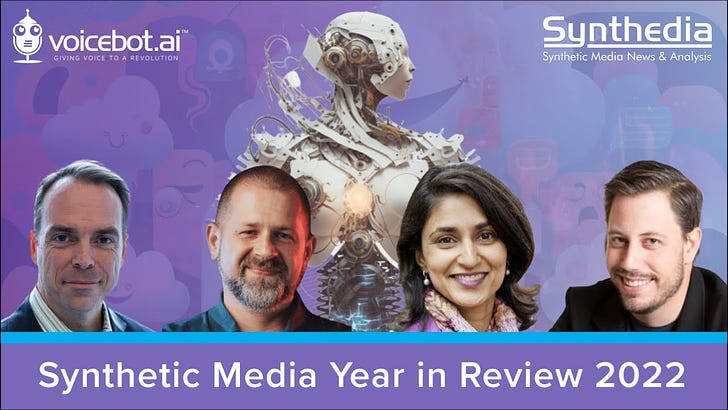Synthetic Media Year in Review 2022 (Video and Podcast)
Generative AI, virtual humans, voice clones, deepfakes (and yes ChatGPT)
Synthetic media broke out of the novelty phase in 2022. And it was really the back half of the year when everything came together. If you are up for a thoughtful discussion about the biggest stories and trends of the industry this past year, I encourage you to watch the video I did for the Voicebot Podcast on the Synthetic Media Year in Review. If you prefer to listen, you can find the Voicebot Podcast in Apple Podcasts, your favorite podcast player, or at this link.
Below are a few of the topics that are covered in the conversation. My guests include Rupal Patel of Veritone, Michal Stanislawek of Hearme.ai and Utter.one, and Eric Schwartz from Voicebot.ai. All three are keen observers of AI and synthetic media technologies and have worked in the industry for years. I am sure you are going to appreciate their perspectives.
ChatGPT, LLMs, and Adoption Drivers
It will not surprise you that we had an in-depth discussion about large language models (LLM) and how ChatGPT changed expectations and enthusiasm overnight. As Stanislawek said, "My Twitter feed exploded." We also tie that to conversational AI and how the two industries are largely separate today but bound to converge.
Text-to-Image Generative AI
If not for ChatGPT and all of the conversational LLM applications, the biggest synthetic media story of the year would have been text-to-image AI models. OpenAI's DALL-E, Stable Diffusion, and Midjourney changed perceptions and immediately saw adoption across art, design, and marketing. DALL-E crossed one million users in about ten weeks, Stability AI claimed 10 million users in October, and Midjourney quickly amassed over two million users on its Discord server. Patel talks about how quickly these solutions have been adopted and also the deluge of digital waste we are creating using AI.
Voice Clones, Deepfakes, and Virtual Humans
Though less explosive in their impact, voice clones, deepfakes, and virtual humans all had their time in the spotlight this past year. Patel talks about how synthetic speech engines have improved and matured, while Stanislawek agrees this has been accompanied by more familiarity with the synthetic voices and their integration into the culture.
America's Got Talent makes an appearance for its showcasing of deepfake technology that made it mainstream overnight and transformed a negative sentiment around the technology into a positive one. We also talk about virtual humans from companies such as Soul Machines, Hour One, and DeepBrain and how celebrities and other public figures are bringing these solutions to the masses.
It was a big year for synthetic media. We have both the audio and video option for you. I hope you enjoy the conversation! There is much to talk about on all of these topics.





